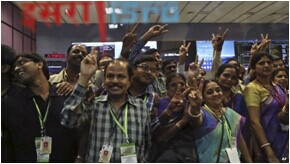
India’s space agency has released its first picture of Mars, taken by its satellite which entered orbit around the Red Planet on Wednesday. “The view is nice up here,” tweeted @isro. A handful of images have been sent by the Mangalyaan probe(探测器)so far. Part of its mission is to study the Martian atmosphere for signs of life.
It is the first time a maiden(初次的)voyage to Mars has entered orbit successfully and it is the cheapest. NASA’s latest Maven mission(任务)cost almost 10 times as much. Media in India have thought highly of the mission as a “historic achievement”. The Hindu newspaper reported that the probe had “sent back about 10 pictures of the Red Planet’s surface which show some craters”. Officials were quoted by the newspaper as saying the pictures were of “good quality”.
India’s space programme has succeeded at the first attempt where others have failed - by sending an operational mission to Mars. It is, without doubt, a considerable achievement. This is a mission that has been budgeted at 4.5bn rupees ($74m), which, by Western standards, is extremely cheap. The American Maven orbiter that arrived at the Red Planet on Monday is costing almost 10 times as much. Back in June, Indian Prime Minister Narendra Modi even joked that India’s real-life Martian adventure was costing less than the make-believe Hollywood film Gravity.
Reports said the camera was the first of the instruments being carried by the satellite to be switched on, a few hours after it entered into orbit.
India’s 1,350kg (2,970lb) robotic spacecraft, which undertook a 10-month-long 200-million-km journey, is equipped with five instruments. They include a thermal imaging spectrometer to map the surface and mineral wealth of the planet, and a sensor to track methane(甲烷) - a possible sign of life - and other components of the atmosphere.
India has become the fourth nation to put a satellite into orbit around Mars, and the first from Asia. Only the US, Russia and Europe have previously sent missions to Mars.
本时文内容由奇速英语国际教育研究院原创编写,禁止复制和任何商业用途,版权所有,侵权必究!
1.Why did India send the Mangalyaan probe to Mars?
A For the purpose of taking pictures of Mars.
B To try its luck in the search of life on Mars.
C With the hope to study the Martian gases.
D To find out if the view on Mars is beautiful.
解析:选B。B 细节理解题。根据文章第一段Part of its mission is to study the Martian atmosphere for signs of life可知,印度火星计划的目的之一是寻找火星生命迹象。
2.What made the Indian media sing high praise of the mission?
A The voyage to Mars cost the least.
B The pictures it took were of good quality.
C It discovered some craters on the surface of the planet.
D It was a historic achievement.
解析:选D。D 细节理解题。根据文章第二段…have thought highly of the mission as a “historic achievement”可知,印度媒体对火星飞行计划取得成功大加颂扬是因为他们取得了“前所未有的成就”。
3.Why does the author mention Hollywood film Gravity in the passage?
A The author wants to prove that the mission is extremely cheap.
B The author tries to show that the mission is as adventurous as the film.
C The author intends to say the Hollywood film can’t compare with the mission.
D The author attempts to prove that reaching Mars is as easy as making the film.
解析:选A。A 推理判断题。根据文章第三段…joked that India’s real-life Martian adventure was costing less than … Hollywood film Gravity可知,印度火星计划投资甚至不如一部美国大片投资多,由此判断,作者在这里提及美国大片《地心引力》是为了证明前文所说的“极为便宜”。
4.What is the function of the sensor equipped on the spacecraft?
A To map the surface and mineral wealth of the planet.
B To help enter the orbit around the Red Planet.
C To detect if the Martian atmosphere contains methane.
D To send back pictures taken by the camera.
解析:选C。C 细节理解题。根据文章第五段…a sensor to track methane…可知探测器上安装的这个传感器是为了探测火星大气层中是否含有甲烷。
5.How does the author think of India’s successful mission to Mars?
A Suspicious.
B Praiseworthy.
C Envious.
D Critical.
解析:选B。B 推理判断题。根据文章中successfully,considerable,historic,succeeded at the first attempt, the first from Asia等词汇判断,作者对于印度火星计划取得成功给予了肯定和赞扬,故选B。